Cite this document
(The Value of the Employees Work Contribution Research Proposal - 1, n.d.)
The Value of the Employees Work Contribution Research Proposal - 1. Retrieved from https://studentshare.org/human-resources/1752128-management-and-decision-making-report
The Value of the Employees Work Contribution Research Proposal - 1. Retrieved from https://studentshare.org/human-resources/1752128-management-and-decision-making-report
(The Value of the Employees Work Contribution Research Proposal - 1)
The Value of the Employees Work Contribution Research Proposal - 1. https://studentshare.org/human-resources/1752128-management-and-decision-making-report.
The Value of the Employees Work Contribution Research Proposal - 1. https://studentshare.org/human-resources/1752128-management-and-decision-making-report.
“The Value of the Employees Work Contribution Research Proposal - 1”, n.d. https://studentshare.org/human-resources/1752128-management-and-decision-making-report.


